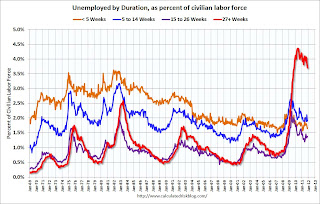by Calculated Risk on 12/02/2011 12:30:00 PM
Friday, December 02, 2011
Seasonal Retail Hiring, Duration of Unemployment, Unemployment by Education and Diffusion Indexes
Here are the earlier employment posts:
• November Employment Report: 120,000 Jobs, 8.6% Unemployment Rate
• Employment Summary, Part Time Workers, and Unemployed over 26 Weeks
• NEW Employment graph gallery (fast, no scripting)
And a few more graphs ...
According to the BLS employment report, retailers hired seasonal workers at close to the pre-crisis pace in November.
 Click on graph for larger image.
Click on graph for larger image.Typically retail companies start hiring for the holiday season in October, and really increase hiring in November. Here is a graph that shows the historical net retail jobs added for October, November and December by year.
Retailers hired 423.5 thousand workers (NSA) net in November, and 547.2 thousand in October and November combined. This is more hiring than last year, and this is about the same level as in 2006 and 2007. Note: this is NSA (Not Seasonally Adjusted).
This suggests retailers are somewhat optimistic about the holiday season.
 This graph shows the duration of unemployment as a percent of the civilian labor force. The graph shows the number of unemployed in four categories: less than 5 week, 6 to 14 weeks, 15 to 26 weeks, and 27 weeks or more.
This graph shows the duration of unemployment as a percent of the civilian labor force. The graph shows the number of unemployed in four categories: less than 5 week, 6 to 14 weeks, 15 to 26 weeks, and 27 weeks or more.Only one category increased in November: The "15 to 26 Weeks" group. This is probably spillover from the increase in short term unemployment in August and September. A little bit of good news is that short term unemployment (less than 14 weeks) has declined.
The the long term unemployed declined to 3.7% of the labor force - this is still very high, but the lowest since October 2009.
 This graph shows the unemployment rate by four levels of education (all groups are 25 years and older).
This graph shows the unemployment rate by four levels of education (all groups are 25 years and older).Unfortunately this data only goes back to 1992 and only includes one previous recession (the stock / tech bust in 2001). Clearly education matters with regards to the unemployment rate - and it appears all four groups are generally trending down.
Although education matters, it appears that the college educated category is declining the slowest (and was the only category to increase in November).
Note: This says nothing about the quality of jobs - as an example, a college graduate working at minimum wage would be considered "employed".
 This is a little more technical. The BLS diffusion index for total private employment was at 54.7 in November, down from 59.6 in October. For manufacturing, the diffusion index decreased to 49.4, down from 52.5 in October.
This is a little more technical. The BLS diffusion index for total private employment was at 54.7 in November, down from 59.6 in October. For manufacturing, the diffusion index decreased to 49.4, down from 52.5 in October. Think of this as a measure of how widespread job gains are across industries. The further from 50 (above or below), the more widespread the job losses or gains reported by the BLS. From the BLS:
Figures are the percent of industries with employment increasing plus one-half of the industries with unchanged employment, where 50 percent indicates an equal balance between industries with increasing and decreasing employment.It appears job growth was spread across fewer industries in November.
We'd like to see the diffusion indexes consistently above 60 - and even in the 70s like in the '1990s.


